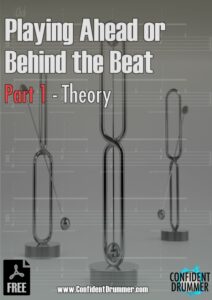Playing ahead or behind the beat has always been kind of a mysterious concept among drummers :-). More than mysterious, confused. In this multi series article we are going to go deep and explore the topic dividing it in three major areas: the theory behind it (PART 1, this post), the exercises to master the skills involved (PART 2), and the examples from records to hear it in practice (PART 3).
Many great musicians are able to choose their approach to keeping time, and decide to play ahead, behind, or right in the center of the beat, based on what the music calls for, what sensation they want to communicate, or what the artist, the producer or the other members of the band ask for.
When we learn to do that, a whole new world of possibilities opens up, since taking things to the next level as far as timing goes has the power to radically transform our playing.
The main reason why it’s important to develop this skill is that changing the place where we position the notes relative to the pulse makes a huge difference in determining the feelings conveyed by what we play, and can be used as a tool to establish a certain feel.
Timing manipulation, and time feel nuances, make it possible to express any emotion we can think of in extremely effective ways.
This type of skill is not for everyone, and also, for certain types of music and for the way some musicians hear music, it could be totally superfluous.
But if we have the passion, dedication and will to push the boundaries of timing and beat placement control, the return in terms of creativity and self expression can be huge.
Before entering these delicate territories, the premise is that we first of all need to make sure that we can seamlessly play exactly on the beat.
Without this foundational skill it wouldn’t make much sense to try and modify our beat placement, because it would be impossible to handle it with an adequate degree of precision.
If we find it hard to stay right in the center of the beat it makes no sense to try to experiment with more advanced versions of beat placement.
As many good teachers say when discussing this topic: playing ahead or behind what beat?
So let’s begin by making sure that we have worked enough on developing a solid inner clock and on playing with a metronome with no effort.
Even ‘just’ keeping regular time is nothing to take for granted, so much so that – paradoxically – even though that should be our primary role, quite few drummers are able to do it flawlessly.
We could actually play an entire career doing nothing other than staying in the center of the beat, and perform any kind of music and be amazing drummers just like that, without using this parameter and especially without going to great lengths to examine it as we are about to do here.
In fact, if we play a slow tempo exactly on the beat it will sound laid back, as if we were a bit behind, and if we play a fast tempo exactly on the beat it will sound exciting, as if we were pushing a little. This, by the way, is one of the reasons why some musicians think that playing ahead or behind is a myth.
It’s in truth very real. The difference is that, once we are clear about where the center of the beat is, and we can comfortably stay there, actually using the ahead/behind placements allows us to affect and amplify the emotions conveyed by our grooves, as we are about to see.
The reason I’m stressing these points is that when working on playing ahead or behind the beat we go into extremely advanced nuances: we are talking about micro timing deviations, milliseconds. No wonder the most common mistake is to overdo this.
If we exaggerate with these techniques, or if we use them without having enough control, we may easily end up destroying the groove.
We are manipulating the foundations of music, and putting our hands on stuff that is very powerful in changing the meaning of what we play.
This is why, if we choose to go in that direction, then we need to take responsibility and educate ourselves to understand the mechanics behind these techniques, because using them sloppily can have disastrous effects.
Enough with the introduction, let’s get right to it.
Each of us has a unique approach to timing, which is part of our personality and style. The tendencies we have to stay in a certain position relative to the pulse determine our natural feel.
Some of us naturally sit right in the center of the beat, some play instinctively a little behind and others tend to play slightly ahead of the beat.
What we can do is work to expand this innate starting point and learn how to control the full range of approaches to timing, so that we are able to choose which feel to infuse the music with, based on what’s needed.
It’s perfectly fine to start from any of these tendencies. The objective is to become more complete and versatile drummers. This does not mean that we throw away our innate qualities.
Instead, by working on these more advanced levels, we will be able to make use of our natural feel with even more awareness.
As far as top drummers are concerned, many of them do nothing but ‘simply’ play right on the beat. Others can sit ahead or behind, using subtleties that they have developed over the course of years of experience onstage and in the studio, that lead them to intuitively adopt a certain approach, using what they feel best suits the music and focusing on the feeling of what they play.
Basically they achieve the same result, even though they may not know how to explain exactly what they are doing.
For example, when I was studying at the Drummers Collective in New York in the early 2000s, during a clinic I asked Kenny Aronoff if he could explain how to play ahead or behind the click. Answer: ‘I’ll show it to you!’ and he went on to perform a piece and play it first by pushing the tempo a bit and then perfectly leaning on the backside of the beat, like a true master.
Another aspect to notice is that many great bands feature amazing musicians whose time feels blend in a particularly successful combination.
For instance, part of the energy we feel from records by The Police comes from the fact that Stewart Copeland had the tendency to push the beat a little.
The band Steely Dan, on the other hand, is more oriented towards a right on the beat approach, and all musicians play precisely in the center.
That’s definitely one of the reasons why their songs sound so elegant and orderly.
In Metallica the heaviness of the guitar riffs is certainly linked to their sound, but a huge component of that weight and power is a result of the choice to play everything behind the beat.
Likewise, drummers like Chad Smith, with their tendency to play in front of the beat, help characterize their band’s sound and feel.
Other drummers, like Josh Freese, play exactly in the middle of the beat and let the tempo of the song determine what feeling is conveyed.
Then there are drummers like Phil Rudd, who plays always a tiny bit behind the pulse, and that few milliseconds lag is a huge part of the deep irresistible groove AC/DC are famous for.
Lastly, as mentioned above, we have drummers that are able to switch between these approaches, and pick the one that best suits the feel and emotions they want the music they are playing to convey.
Among them we have musicians like Steve Jordan, John JR Robinson, Jeff Porcaro, Matt Chamberlain, Mark Schulman, Vinnie Colaiuta, Jim Keltner, Kenny Aronoff.
It is no coincidence that among these names there are some of the finest drummers in the music industry, who have played on thousands of records.
Back to the point, what we are about to do here, on the other hand, is going through a very analytical process. As usual, we need to take one step back in order to take two steps forward.
Obviously the objective is to create emotions and convey sensations with what we play, but being purely instinctive leaves too much room to chance, and our goal here is to be very methodical so that we can learn how to take control of the effect that we achieve, in a short time.
It’s important to stress that even though we are going to talk about milliseconds, music is not created by moving around milliseconds, it’s made of emotions.
The intention is to figure out things, go deep, understand all aspects involved, and then let go all of it and go back to focusing exclusively on feel and sensations.
It’s ok to think about this stuff while we practice, but if when we are onstage we are thinking about being ahead or behind the beat, we are really losing – and probably ruining – that musical moment.
Another important clarification is that playing ahead or behind the beat doesn’t mean rushing or dragging: instead it means playing perfectly in time, yet establishing a certain relationship with the beat. The bpm remains the same!
We are not talking about speeding up or slowing down, it’s about making sure that the slight deviations from the beat that we apply are just perceptible.
Not necessarily hearable by ear, but noticeable in terms of sensations being transmitted, which is exactly what we want to achieve.
All of this while playing inside boundaries within which nothing starts to sound weird.
To download a free PDF printable version of this article, click here:
To understand what it feels like to play in front of the beat or on the backside, we can use this analogy: let’s imagine a big ball, which we consider the pulse, and on which we stand keeping our balance.
When we keep perfect time we do a pretty remarkable thing: we know how to stay perfectly balanced on the center of the ball. That’s already an impressive result.
But if we work on developing advanced timing skills, then we can learn how to lean forward a little bit, and, even though that creates a bit of tension and thrust, we can still keep our equilibrium.
At the same time, no matter how good we are at it, if we lean forward too much we are going to fall off the ball, and we are going to be off time.
On the other hand, we could relax and lean back a little, thus being behind the beat. Even is this case, though, if we relax too much we fall off the ball, and again we are going to be out of time.
Fundamentally, sticking to this analogy, mastering ahead and behind the beat subtleties means nothing more than developing lots of control and sensitivity around keeping our balance on the beat, so much so that we can go for extreme positions without that necessarily causing us to fall off the ball, that is fall off time and speed up or slow down.
As said before, each of us, and each musician, has an innate predisposition.
But, like for any other skill, with practice we can work on the details, improve, correct any unwanted tendencies and master every possible positioning inside the pulse.
In PART 2 of this course we are going to see exactly how to do that.
Since these are relative terms, if we want to talk about ahead, on the beat, or behind, we need to have a reference.
Such reference is the center of the beat, and, in order to be able to choose how to relate to it, everyone in a band needs to know exactly where it is.
The pulse can be provided by an external device (the metronome, typically in the studio and now almost always even in live shows), by the drummer, or by a set of instruments (mostly the rhythm section).
In a band these subtleties can only be handled if all the members have great timing, are confident and are able to stick to their own beat placement, without falling in the mistake of making adjustments towards someone positioned in a slightly different way, including, of course, the metronome.
Essentially, the way in which we relate to the pulse determines the feel of what we play in the following ways:
- Exactly on the beat: solidity, pocket, strength, certainty, confidence.
- Behind the beat: weight, density, laid back feel, intensity, relaxation, air, solemnity, importance. But if we overdo it, it becomes lack of energy and floppiness.
- Ahead of the beat: excitement, momentum, drive, passion, energy, power, urgency, push. But if we overdo it, it becomes anxiety and tension.
The secret to making these techniques work is the consistency with which we provide our pulse: it doesn’t matter if we tend to sit a bit ahead or behind, because whoever plays with us learns to relate to the way we interpret the beat and to play along with that.
But in order to do it they need consistency. In other words they need to be able to trust that we are going to stick to a certain approach and not change things every two bars.
As already said in the lesson about micro rhythms, consistency, regularity, control and confidence are the characteristics that make what we play ‘right’.
To apply the ahead/behind technique on the drums we can intervene on 2 levels:
- The option of either utilizing only one limb to create the effect wanted (usually the Snare Drum) or alternatively involve all limbs simultaneously.
- The choice about the extent of the deviation from the center of the beat.
Each approach has different outcomes, because if we reposition everything the effect of being ahead or behind will be stronger, and with that the risk of slipping out of time will be higher.
Also we could create excessive tension against the rest of the music, thus ending up paying too big of a price for the result we intended to achieve in the first place, and destroying the feel in the process.
This is especially true in situations in which we play along samples and electronic loops, because in these scenarios even the slightest flam compromises the feel of the performance.
Actually, the more live elements we have (not quantized instruments), the higher is the margin we can experiment with before things start to sound weird.
Moving just one part is a much more balanced and subtle solution, which allows us to get very similar results without taking as many risks.
As a matter of fact, a technique used by producers who program drum parts is exactly placing everything on a quantized grid and in the center of the beat, except for the Snare Drum which gets delayed by a few milliseconds, because doing that generates a deeper groove without compromising the precision that is required when electronic tracks and parts are involved.
The other side of the coin is that in situations with no electronics involved (or at really slow tempos) moving just the Snare, or just the Bass Drum or the Hi-Hat, may not be powerful enough to give us the feel we wanted.
Furthermore the effect will be amplified or reduced based on the amount of the second component involved, which as we said is the quantity of the deviation away from the center.
The limbs that we move, and how much we move them, can be combined in endless ways to create the desired effect, situation by situation.
As explained we are talking about very subtle nuances, which operate in the milliseconds range. So now let’s discuss this part of the equation.
While learning to control this parameter, one of the crucial components is the ability to place notes ahead or behind the beat in at least two quantities.
Years of experience in the recording studio and countless hours of experimentation, recording, listening back and cross referencing with the opinions of lots of expert drummers, have led me to identify in 5 and 10 milliseconds the two most effective amounts.
The extreme to which we can push it is 20 milliseconds. Anything beyond this starts to convey an ‘out of time’ sensation, and therefore goes beyond the range within which these techniques work and make sense.
As said before, if in a band everything is played live then there is a wider margin, and even 15 or 20 milliseconds can be acceptable. The reason this is the case is that musicians listen to each other and are a lot more flexible in accommodating each other’s tendencies.
On the other hand, if we play with electronic loops and samples, sticking to 5 or 10 milliseconds max is the way to go.
To wrap this first part up, it’s important to point out that playing with feel doesn’t necessarily have something to do with playing ahead or behind the beat.
Just like playing exactly on the beat doesn’t automatically mean being emotionless. We can be precisely on the beat and have amazing feel.
The reason is that since we are actually never perfectly on the beat (to the level that only a drum machine can), even when we think we are using such approach there are still micro nuances and placements that determine the feel we produce.
There will always remain an intangible part that cannot be defined, but, when present, can be noticed: and the magic is there.
Now that we have a clear understanding of the foundational concepts involved, we can move on to PART 2, where we are going to discover exercises that will take us from zero to masters of the ahead and behind the beat skill.
Related resources:
PART 2 – Exercises
PART 3 – Examples
‘Groove Mastery & Formulas’ – Altitude Drumming – Volume 8
‘Click & Timing’ – Altitude Drumming – Volume 6
‘Theory & Concepts’ – Altitude Drumming – Volume 1




















